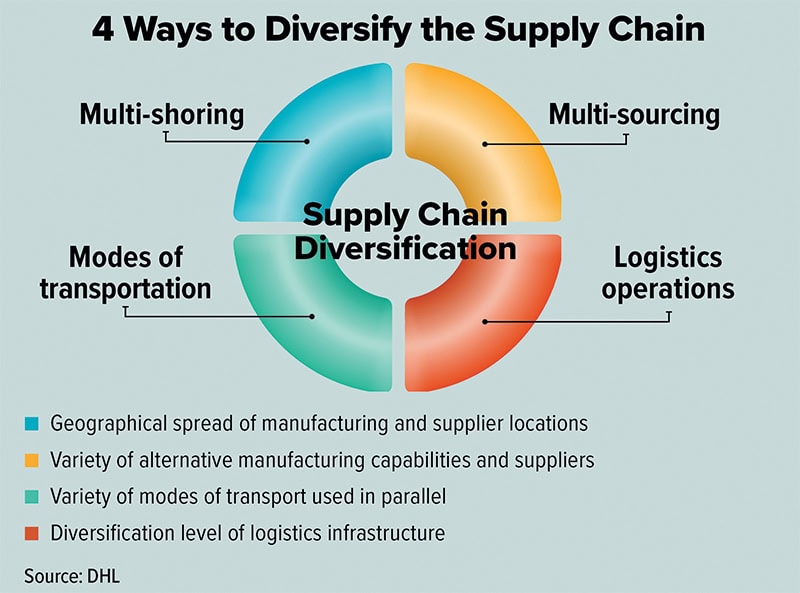What’s the Word? The Language of Logistics

What are the components of supply chain diversification? What’s the difference between GenAI and general artificial intelligence? Here are explanations of some oft-used but not often well-defined supply chain terms.
Gen AI vs. AI
Artificial intelligence is the science of computers mimicking human intelligence to solve problems. In supply chain management, AI can optimize operations by predicting demand, managing inventory, and improving logistics. For instance, machine learning algorithms analyze historical data to forecast future stock needs, reducing the risk of overstocking or stockouts.
Generative AI or GenAI is one type of AI that enhances supply chains by generating synthetic data to simulate different scenarios and optimize decision-making. For example, it can create demand variations under different conditions, helping companies prepare for potential disruptions and improve resilience.
What’s the Most Impactful AI for Supply Chains?
Predictive AI and machine learning have the greatest implications on supply chain planning. ML algorithms can analyze large volumes of historical data to identify patterns, correlations, and trends.
Generative AI, especially the recent methods based on Large Language Models, is in the early stages. GenAI is useful for creative applications, data augmentation, and simulations.
However, in the enterprise business context where each decision can have millions of dollars of impact, a lot more care and attention needs to be put to make sure they work reliably, and the decisions and automations can be trusted.
GenAI will be mostly used for productivity and automation, and we will see narrow applications of GenAI here and there in the near future. However, their use in the more general setting is an open area of research and investigation.
–Behrouz Soleimani, PhD, Head AI Scientist, Kinaxis
Counterpoint: Generative AI Will Have the Greater Impact on Supply Chains
Generative AI is poised to have a more significant impact on supply chain management compared to traditional AI. Its ability to fundamentally change the way business is conducted offers substantial potential for innovation.
Generative AI is being integrated across various aspects of supply chain management, from planning and logistics to customer interaction and compliance.
For instance, it can enhance scenario planning, provide decision recommendations, and streamline customer interactions with conversational AI. This transformative potential makes generative AI a powerful tool for reimagining end-to-end supply chain processes.
This technology is also making significant improvements for supplier management and sourcing by generating insights based on a wide range of supplier data. For example, generative AI can review standard details such as supplier performance, capabilities, and cost to provide recommendations on which suppliers to engage with.
–Jeff Trino, Vice President, Supply Chain, Genpact
Spelling It Out
FVL
Finished vehicle logistics refers to the processes involved once a vehicle exits the factory. Managed by an OEM or a third-party outbound logistics team, it includes final preparation, staging for pick-up, and dealer drop-off. A typical factory produces more than 1,000 vehicles per day, which are stored in immense outdoor lots. Efficiently locating and moving the correct vehicles saves fuel, reduces the possibility of damage, and improves employee satisfaction.
–Michael Ueland, Chief Revenue Officer, Cognosos
OBC
On-board couriers. A specialized air freight service for high-value products. OBC offers a hands-on approach—a courier accompanies the shipment from its origin, boards the plane, clears customs, and personally delivers it to the recipient at the final destination.
–Andrew Rossell, VP of Operations, ASF Global Logistics
Bot Talk
Machine Customer
A nonhuman entity autonomously procuring goods or services. Examples include:
- IoT-connected devices or assets that place orders independently of a human command
- Intelligent replenishment algorithms that maintain availability of consumables
- Intelligent assistants that suggest deals to consumers.
Robot Wrangler
A warehouse worker in charge of managing and leveraging robots. As more companies deploy automation in their logistics operations—approximately 21% of warehouses used some form of robotics in 2023, up from 15% in 2018, according to Interact Analysis—they seek workers who can implement robotics projects and help others work alongside robots in supply chain workflows.
